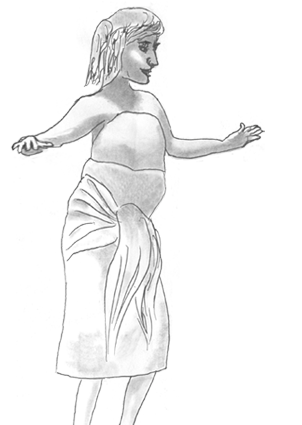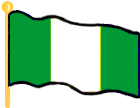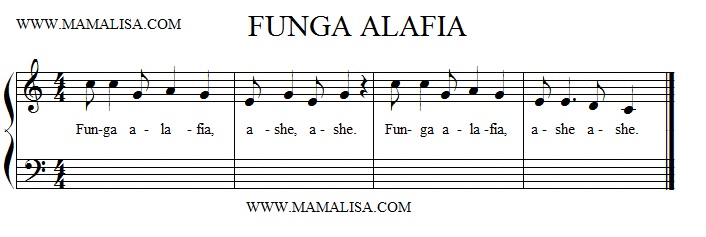Fanga Alafia
This is a "welcome dance" song that's sung as a call-and-response. You'll typically find the name as "Fanga Alafia".

Fanga Alafia
Hello, Peace
Welcome Song
Welcome Song
(Yoruba)
(English)
Fanga àlàáfíà,
áṣẹ, áṣẹ.
Call: Hello, peace.
Response: Let it be so, let it be so.
Notes
Further explanation of the lyrics...
Yoruba Words
1. Alafia: A greeting, with the meaning of "peace" (like "shalom"). Alafia is a type of traditional welcome dance.
Gabriel wrote from Nigeria, "The word àlàáfíà was borrowed from Hausa and in Hausa it is spelt 'lafia', meaning, peace.
The correct spelling is àlàáfíà. The original Yoruba word for Àlàáfíà (peace) is ìfọkànbalẹ̀ (literally, 'a situation in which the heart is at rest'). Àlàáfíà is commonly used because it is more colloquial. In greeting we say at the door, Àlàáfíà fún onílé yìí, peace be unto the residents of this house, and the residents reply, àlàáfíà fún ọ, peace be unto you. However, the everyday greeting among Yorùbá depend on the time and/or what you are doing: Good morning, ẹ káàárọ̀; Good afternoon, ẹ káàsán, Good evening, ẹ káalẹ́, Good night, ó dàárọ̀. Ẹ kú oríire, congratulations, Ẹ kú ìdúró (roughly, 'happy standing up') to show that there is a greeting for every situation or occasion."
2. Fanga: A traditional welcome dance which originated in Liberia or Sierra Leone, according to Wikipedia. (It's often misspelled as "funga".)
3. áṣẹ/ashe: New explanation by Gabriel from Nigeria: "The word "ashe" is written in Yorùbá as "áṣẹ". It literally means "let it be so" or "may it be so". As in my name, Ọ̀shọ́, sh was used by colonial masters instead of ṣ, which is more acceptable now...
Old Note for áṣẹ/ashe: (Pronounced "ah-shay") The Yoruba believe "ashe" is a basic force emanating from the Creator that unites all living and non-living things.
Comments
According to Wikipedia: "Fanga is a dance 'interpretation of a traditional Liberian invocation to the earth and sky'. The dance originated in Liberia or Sierra Leone. The first performance of a version of Fanga in the United States may have been by Asadata Dafora in 1943; Marcia Ethel Heard believes that Pearl Primus hid Dafora's influence on her work. The dance was written by Primus in 1959 in conjunction with the National Dance Company of Liberia. Fanga was one of the dances through which Primus sought to stylize and perpetuate African dance traditions by framing dance as a symbolic act, an everyday practice, and a ceremony. It was then further popularized by Primus' students, sisters Merle Afida Derby and Joan Akwasiba Derby. Babatunde Olatunji described Fanga as a dance of welcome from Liberia and he, and many others, used a song created by LaRouque Bey to go with the rhythm and dance, assisted by some of the students in his Harlem studio, during the early sixties. Bey used words from the Yoruba and Vai languages (alafia = welcome; ashe = so be it; fanga = drum) and an African American folk melody popularized by American minstrels (Li'l Liza Jane)."

You can hear background music for this song in the mp3 recording below...
Many thanks to Mackenzie Wang for sharing the background music to this song! Mackenzie wrote, "We sang a few songs that I found on your website in a little outdoor spring show last month, and my husband and I created backing tracks for each. I would love to provide them to you so they can be shared with the community."

Thanks!
Thanks!
Thanks!
Thanks and Acknowledgements
Many thanks to Gabriel Olubunmi Osho-Davies for the correction and explanation of the meaning of the song.
Thanks to Monique Palomares for the illustration.
Ese!

























